Clock Foundation’s GrimAge Biological Age Test Review
Epigenetic age test provides information beyond biological age
Join the club for FREE to access the whole archive and other member benefits.
Like many people interested in life extension, the question top of my mind is whether I’ll live long enough to live forever? Will I be around when the first- and second-generation treatments arrive that add 5 to 15 years to my life expectancy, to reach the singularity and beyond, when new life extending therapies arrive faster than I’m aging.
The answer to that question is heavily based on chronological age (i.e. the time I have been alive) but individual life expectancy is also swayed heavily by biological age – the equivalent age based on the state of the body - from organ function down to cellular function.
This is the second test I’ve taken to find out just how old I am inside. My first used GlycanAge’s kit that analysed my glycome. Here, I look at the myDNAge test that uses my epigenome to determine my biological age.
In summary, epigenetics is the explanation for how we have hundreds of types of cells in our bodies even though they all have exactly the same DNA. Not only does the DNA which gets expressed vary by cell type, but it also varies over time.
Quick biology lesson: Almost every cell in the body contains a nucleus that holds a copy of that person’s DNA (there are a few exceptions, such as red blood cells). The DNA includes the genetic code that tells the cell how to create proteins – and it is proteins that do most of the work in the body. However, not all cells need the same proteins for them to do their work – for example, liver cells need proteins that break down alcohol, whereas brain cells need to produce dopamine to communicate with other cells. Which genes are “expressed” in a cell (i.e. which genes can be read and translated into proteins) determine the cell’s function.
One of the first checkpoints as to whether a gene will be expressed is chromatin accessibility. Remember that DNA in a cell is not a single long strand, it bundles up in a variety of ways. Firstly, it wraps around histones, and these then group together to create a fibre-like structure called chromatin. Finally, the chromatin bundles up into one of your 23 pairs of chromosomes.
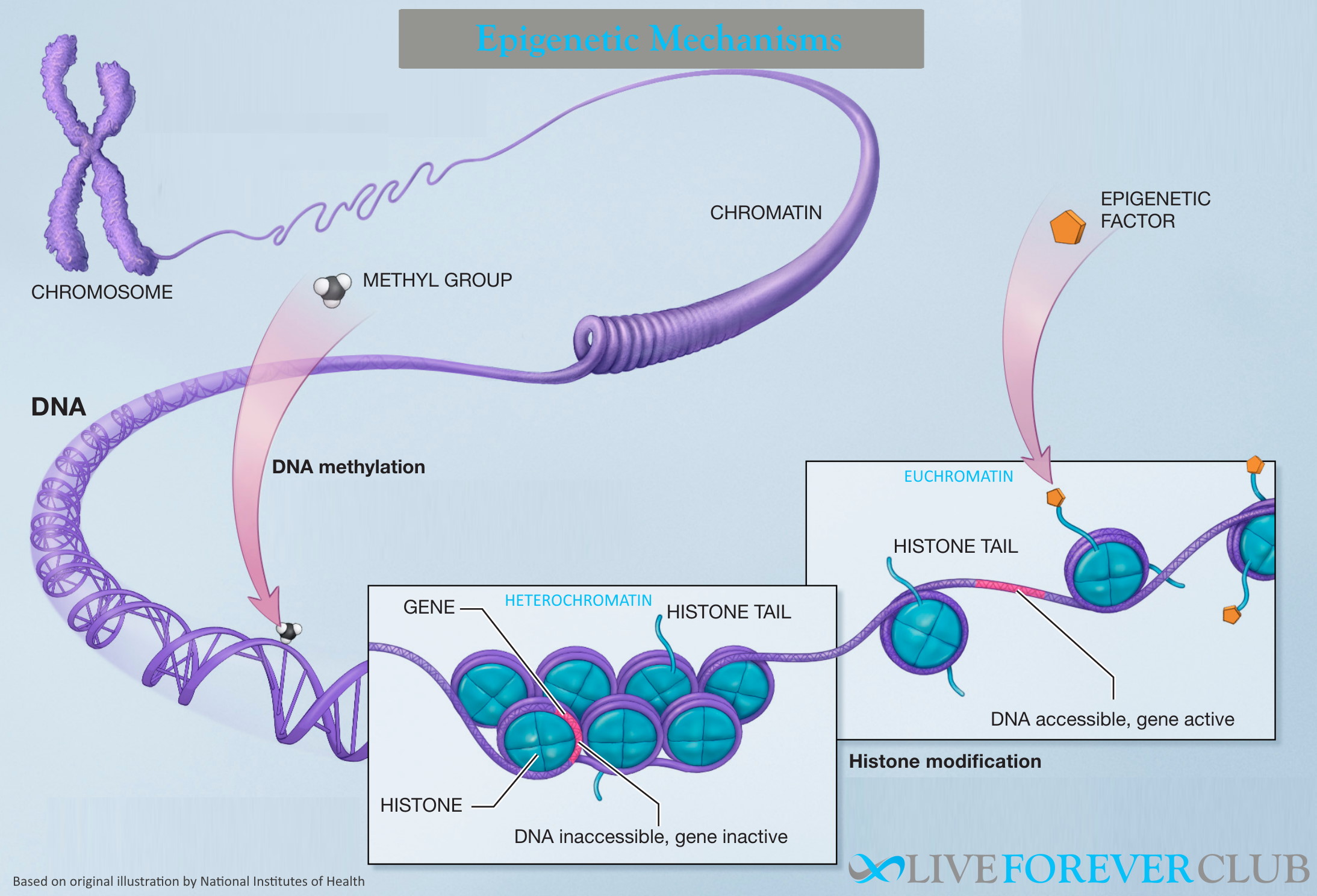
So back to the chromatin. Regions of chromatin where genes are easily accessible are called euchromatin, and where it is densely packed (so hard for the genes to be transcribed) it is called heterochromatin. Whether the chromatin is loosely or tightly packed is determined by chemicals tagged to the histones - acetylated histones are expressed, whereas methylated histones are repressed. Methylation tags can also attach to individual genes preventing them from being expressed.
The epigenome is the pattern of chemical tags at both histone and individual gene level that determines which genes are expressed.
Given that when a muscle cell divides it divides into more muscle cells (i.e. expressing the same genes) then it is clear that the epigenome is passed on to child cells – only at conception does everything get rewound to DNA time zero. This also means that epigenetic changes due to environment factors, or ageing, are also passed on to divided cells. Interestingly, in some cases, they can also be inherited by children.
How does the myDNAge biological age test use your epigenome to determine your biological age? Well, it uses something called an epigenetic aging clock.
Although a cell’s starting epigenome is established during early development (to define what type of cell it is) this base pattern of gene expression changes over time. And it turns out that the pattern seen in this drift is related to your age, and even to your risk of death.
Epigenetic age methods are based on research by Dr. Steve Horvath – hence the original one was called the Horvath clock. His work is based on the location of methylation sites, known as CpGs (or cytosine-guanine dinucleotides if you must ask!). The original clock identified 353 CpGs which reasonably accurately determine chronological age, and since then his team has developed clocks that better correlate with other biomarkers of aging (PhenoAge) and mortality risk (GrimAge).
Given that myDNAge is looking at over 2,000 genetic loci, it is probably fair to assume that they are using a pattern recognition similar to one of the later clocks.
myDNAge kindly provided the test for free to the club so that I could share my experience of it – though, as always, this post is editorially independent, reporting as if I had paid for the test. Usual price is $299 and they ship to the UK, rest of Europe, USA, Canada, and Australia.
The test kit arrived with all of the equipment well organised into separate packages. I particularly like the box design which has a built-in sample tube holder.
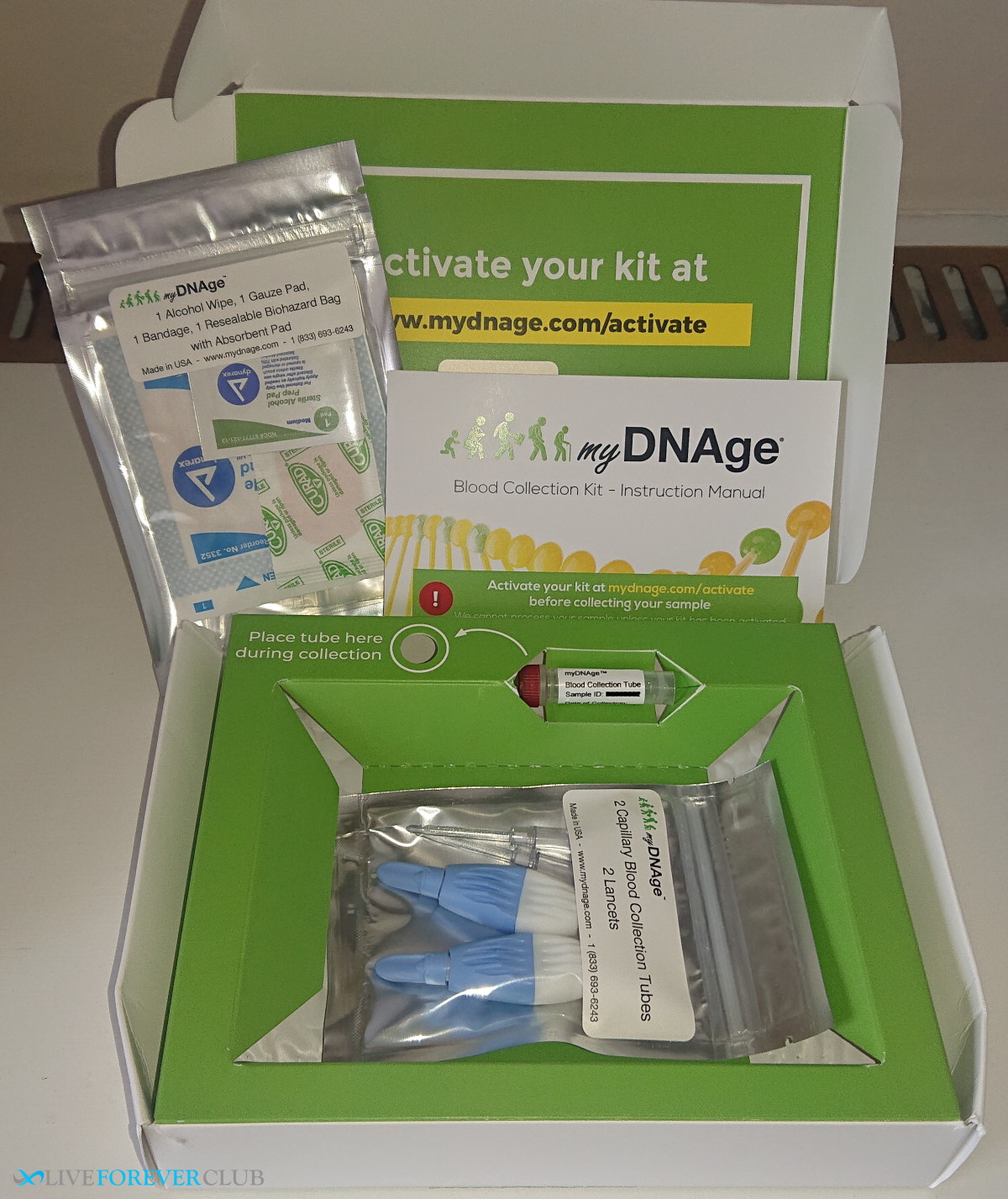
The instruction leaflet was nice and clear – though I did get a bit confused about the fill line, see below.
Everything you need is in the box – even a plaster to put on your finger afterwards.
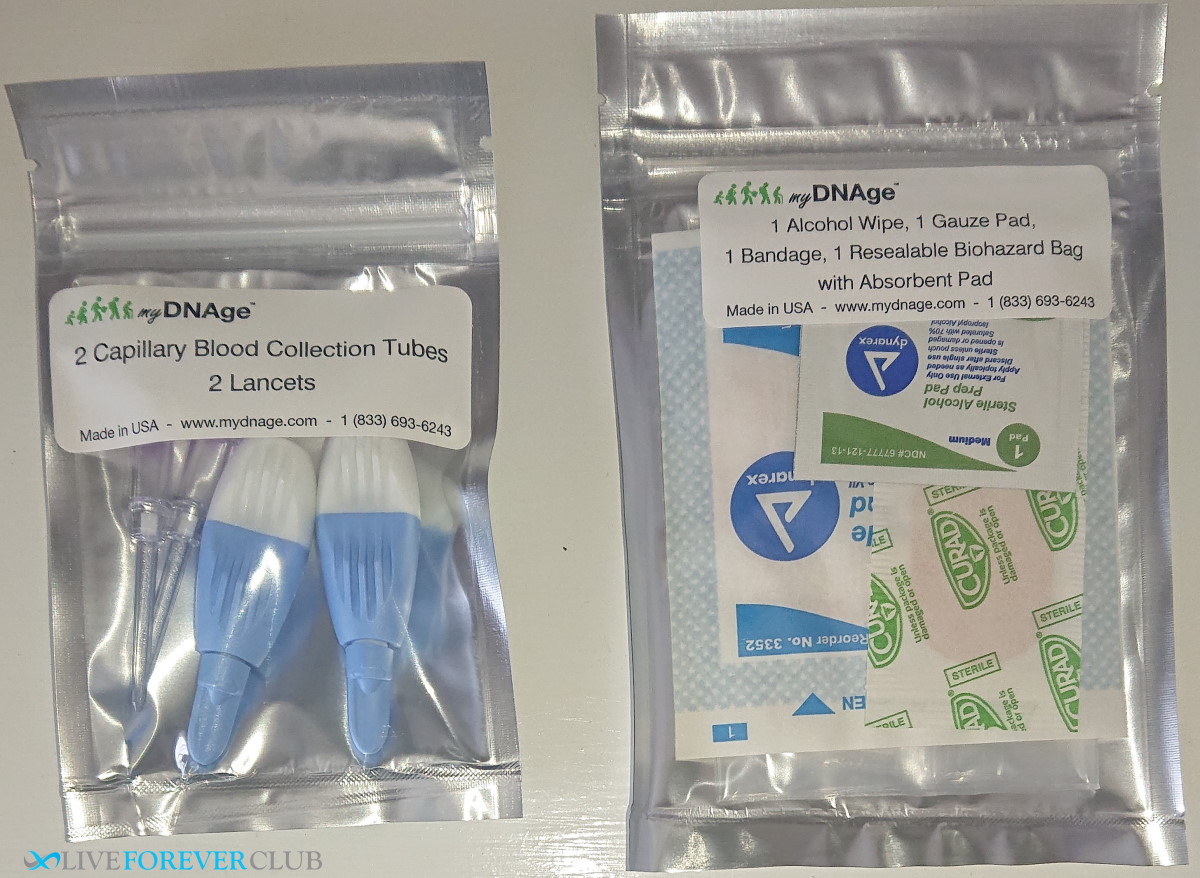
Taking the blood sample was straight-forward and will be familiar to anyone who has taken any kind of home blood test before. Wipe your fingertip with the alcohol swab and use the spring-loaded lance to prick it – all pretty painless. Once a blood drop forms, then fill the capillary tube to the “full” line.
This is where I got into a bit of a mess. I was holding the capillary tube the right way up, but mentally struggled to understand that full was measured from the top, not the bottom. So even when the capillary tube was full, I was expecting the blood to drop into the main chamber and then fill UP to the full line from there, not DOWN to the full line from the tube.
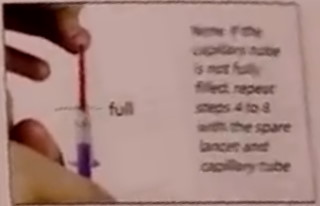
Checking afterwards, the diagram does clearly show the blood above the “full” line. However, it did mean I got blood everywhere (running down the side of the tube!) while waiting for the tube to fill up which it never did. I’ll read the instructions properly next time :)
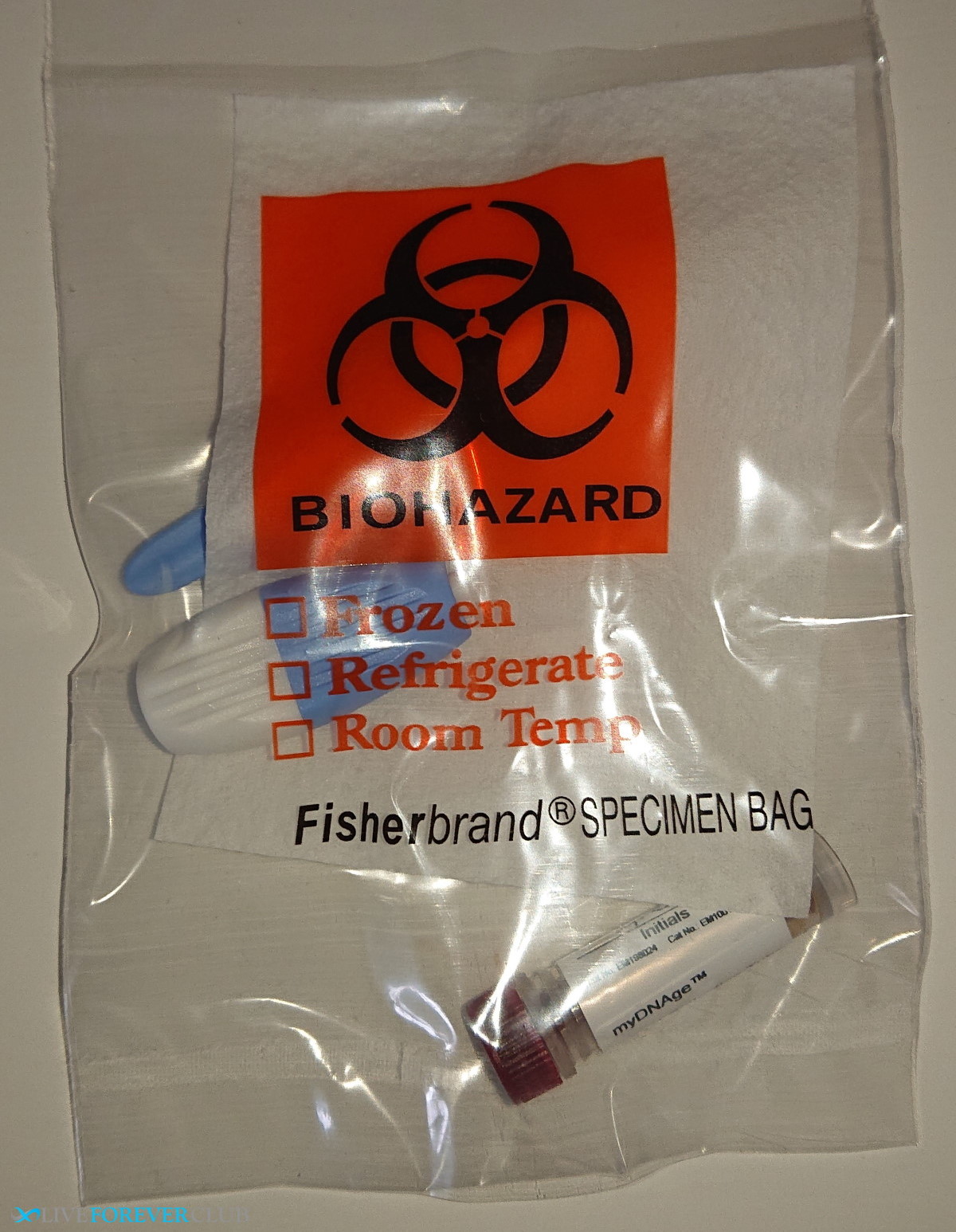
After that, it was a simple case of transferring the blood into the sample container – the capillary tube doubles as a simple syringe to expel the blood into the vial which contained some sort of stabilising solution. After sealing the vial, and turning it over a couple of times, it was ready to put in the prepaid UPS package and send back.
I received an email acknowledge a few days later when they received my sample, with an indication that the result would be ready within 6 to 8 weeks, though mine took a bit less than that.
So just over a month later, a nice enticing email arrived to reveal my DNAge…
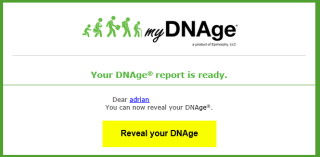
Once logged in (where you could also previously track your sample) you can download a short report that includes 3 main ways of viewing your biological age:
My biological age (“DNAge”) turned out to be 55, compared to being 50 years-old at the time.

Disappointing given I try my best to live a healthy lifestyle, and definitely want to reach the first bridge to biological immortality, but at least it was better than my GlycanAge result. The grey bars indicate the median of 2 standard deviations of replicated tests, but clearly, I’m aging faster than average.
The report then shows where I am compared to other participants:

If my biological age matched my chronological age then I assume the result would be 50% - so no surprise it is a lower than that. Though possibly surprising that a few years difference between the two ages quickly puts me in the bottom 20% of people.
Finally, how I compare to other people is displayed on a scatter plot (I’ve added in the “biological age = chronological age” blue line). This one actually makes me feel a bit better – there is a quite a spread either side of the line, and I’m far from being an outlier. Though, of course, I would definitely prefer to be below it!
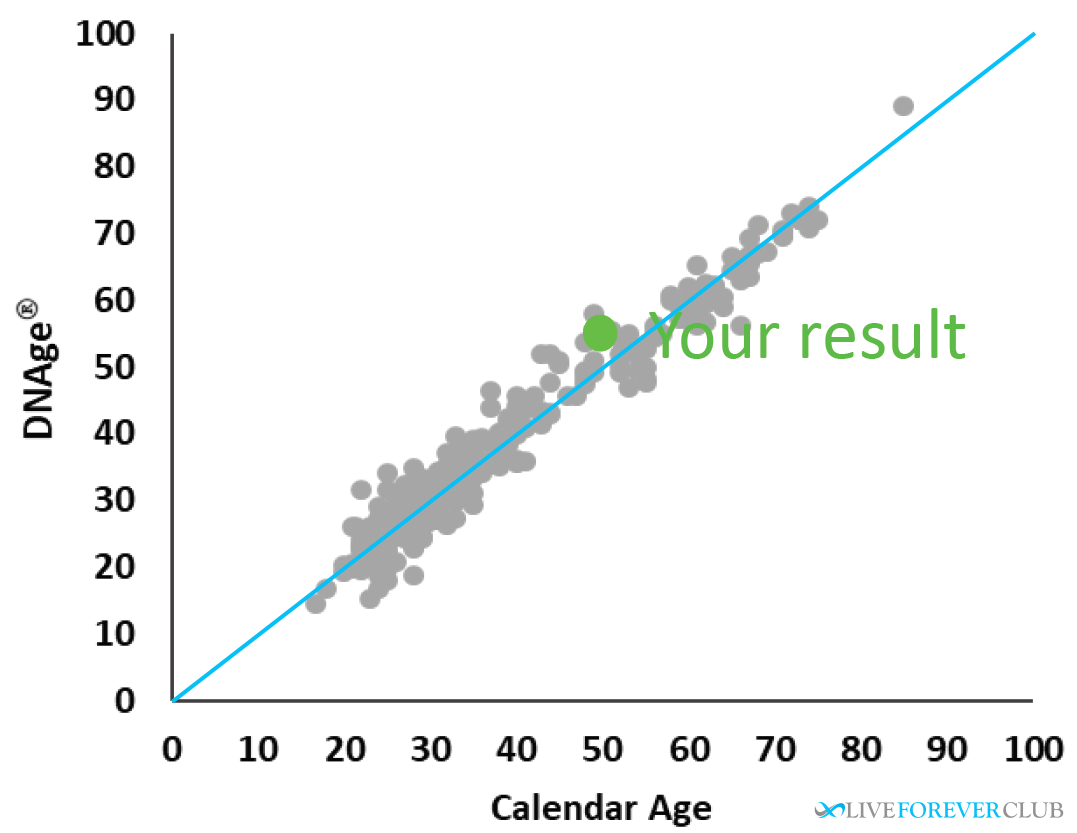
I’m not going to shoot the messenger, so although I’m not happy with my result, I was happy with the product and service. The sampling kit was easy to use and the instructions were clear; with prepaid postage to no fuss in returning my sample. Maybe it would be good to get some raw data from the test (though I’m not sure what I would do with it), but providing a comparison with other people (percentile and scatter graphs) helped put into perspective where I stood.
The myDNAge test is definitely something I would consider doing on a regular basis to see whether I’m still ageing faster than I should be.
Overview: Eukaryotic gene regulation – Khan Academy
Epigenetics: How the environment influences our genes – Encyclopaedia of the Environment
What is the myDNAge Test? – myDNAge
Click on resource name for more details.
GlycanAge Biological Age Test Review
Carbiotix Gut Health Test Review
Epigenetic age test provides information beyond biological age
Rate of shortening, shape and method of testing are all important factors
What can your glycome tell you about your true age?
Adrian tries out this home epigenetic test and is impressed with the level of detail in the reports
How does the cheapest epigenetic age test on the market compare?